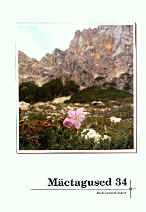Eesti etnofarmakognoosia elujõust kummelite näitel
About the Vitality of Estonian Ethnopharmaconosy on the Example of Camomile
Author(s): Elmar Arak, Ain RaalSubject(s): Anthropology
Published by: Eesti Kirjandusmuuseum
Keywords: Estonian ethnopharmacognosy; folk medicine; pharmacy; medicinal plants; camomile
Summary/Abstract: The ethnopharmacognosy is an acknowledged and modern trend when it comes to discovering new medicinal plants and broadening the field of use of the herbs that have been known for a long time. Throughout times, camomile has been the most widely used medicinal plant. It is also the most popular herb in the former Soviet Union and in Russia, and is also widely used in Germany, etc. In Estonia, two types of camomile can be found. The German camomile with white ligulate ray-florets (Chamomilla recutita (L.) Rauschert, syn. Matricaria recutita L., syn. M. chamomilla L.) grows only here and there in nature and the drug is mainly obtained from cultivating the plant. Pineapple weed without ray-florets (Chamomilla suaveolens (Pursh) Rydb., syn. M. suaveolens (Pursh) Buchen, syn. M. discoidea DC., syn. M. matricarioides (Less.) Porter p.p.) is a widely spread weed in the nature. The Pharmacopoeia of the Soviet Union, which was effective in Estonia for half a century, permitted the use of the inflorescence of pineapple weed as a substitute for the inflorescence of German camomile, but only for external use. According to the pharmacopoeia, the camomile inflorescence has an anti-inflammatory and spasmolytic effect. Different authors have different viewpoints as regards the internal use of the pineapple weed. It is also unclear whether pineapple weed could be used as a substitute for German camomile. The present article analyses the vitality of Estonian ethnopharmacognosy with the example of camomile as our most popular medicinal plant. The available folk medicinal data has enabled us to propose the following hypotheses: 1. The complex of biologically active substances is chemically and pharmacologically close in case of pineapple weed and German camomile. 2. The complex of biologically active substances of pineapple weed and German camomile is quantitatively similar in inflorescence, as well as in leaves and stalks. It is possible to use the drug instead of the inflorescence. 3. Pineapple weed can be used for internal purposes.
Journal: Mäetagused. Hüperajakiri
- Issue Year: 2006
- Issue No: 34
- Page Range: 149-184
- Page Count: 36
- Language: Estonian

